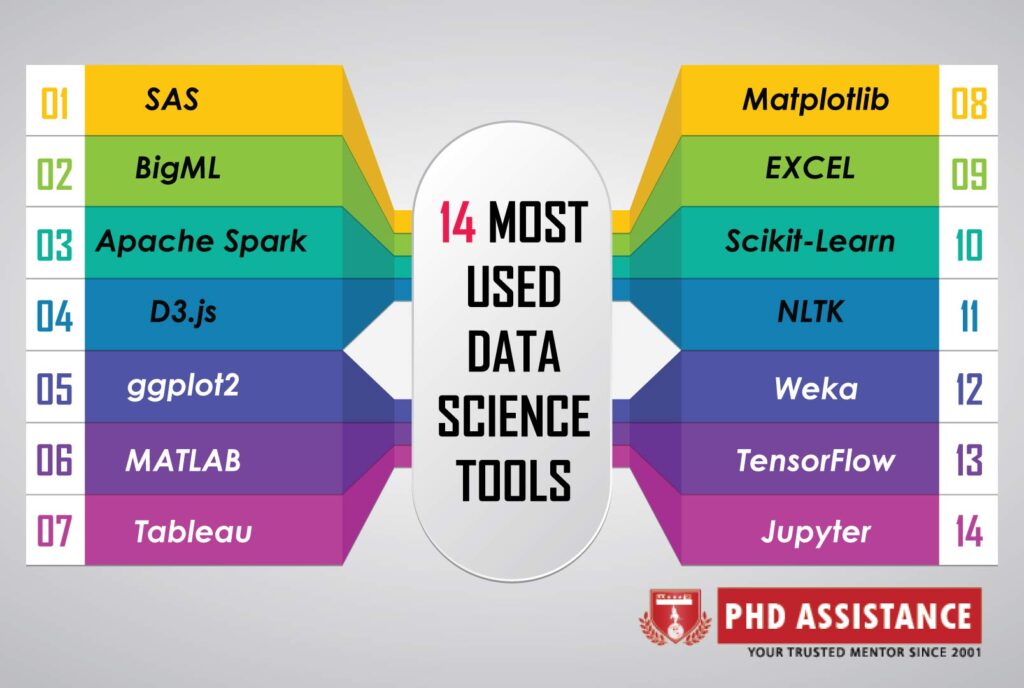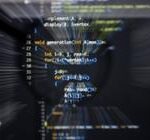Coding Software and Tools used for Data Science Management
The technique of extracting usable information from data is known as data science. This is the procedure for collecting, modelling and analysing, data in order to address real-world issues. Data Science tools have been developed as a result of the vast range of applications and rising demand. The following section goes through the greatest Data Science tools in detail.
The most notable attribute of these tools is that they do not require the usage of programming languages to implement Data Science. They have pre-defined functions, algorithms, and a user-friendly graphical user interface. Several start-ups and IT behemoths are attempting to provide such user-friendly Data Science solutions [1]. However, because Data Science is such a large process, using only one tool to complete the process is rarely sufficient. Phdassistance experts have experience in working with Data Science tools. Talk to Expert

Figure 1: 14 Most Used Data Science Tools [1]
Apache Hadoop
Apache Hadoop is really a freeware, open-source system for storing and managing massive amounts of data. It allows enormous data sets to be dispersed across a group of hundreds and thousands of machines for processing. It’s utilised for data processing and high-level calculations. The Hadoop Distributed File System (HDFS) is utilized for data storage in this programme, which distributes large volumes of data over several nodes for distributed, parallel processing. Various data analysis components, such as Hadoop YARN, Hadoop MapReduce, and so on, are made available through this module. Phdassistance assist you in coding software tools. Order Now.
Microsoft HD Insights
Microsoft’s Azure HD Insight is a cloud platform that allows you to process, analyse, and store data. Milliman, Adobe, and Jet are among the companies that utilise Azure HD Insights to handle and manage vast volumes of data. It has complete integration support for Spark clusters and Apache Hadoop for processing data. Microsoft HD Insights uses Windows Azure Blob as its default storage system [2]. It can handle its most sensitive information among thousands of servers with ease. Microsoft R Server is a server that enables enterprise-scale R for statistical analysis and the creation of robust Machine Learning models.
Informatica PowerCenter
The fact that Informatica’s sales has tapered off to roughly $1.05 billion explains the hype around the company. Informatica provides a variety of data integration products. Informatica PowerCenter, on the other hand, stands out owing to its database converged infrastructure. Based on the ETL (Extract Transform Load) design, a data integration tool is designed. It assists in obtaining data from a variety of sources, converting and processing it to meet business needs, and then transferring or releasing it into a storehouse.
RapidMiner
RapidMiner is among the most useful software for adopting Data Science, which comes as no surprise. RapidMiner was named to the Gartner Magic Quadrant for Data Science Platforms 2017, the Forrester Wave for Machine Learning and Predictive Analytics, and the G2 Crowd predictive analytics grid as one of the best performers. A unified platform for processing data, machine learning model development, and deployment [3]. It has support for combining the Hadoop framework with all its RapidMiner Radoop in-built.
H2O.ai
H2O.ai is the business behind H2O, an open-source Machine Learning (ML) solution that aims to make ML more accessible to everyone. H20.ai is a free and open-source data science application that aims to make data modelling more straightforward. Because most engineers and data scientists are comfortable with R and Python, applying Machine Learning is easy. It can use a variety of Machine Learning techniques, such as generalised linear models (GLM), classification algorithms, and boosting machine learning, to name a few. It supports Apache Hadoop integration for processing and analysing massive volumes of data.
Phdassistance experts has experience in handling dissertation and assignment in Engineering research with assured 2:1 distinction. Talk to Experts Now
DataRobot
DataRobot is an AI-powered automation tool that assists in the creation of precise prediction models. DataRobot provides a variety of Machine Learning methods, such as regression models, clustering, and classification, simple to implement. Allows hundreds of servers to be used to facilitate multiprocessing to do data processing, modelling, validation, and other tasks at the same time. DataRobot examines the models on a variety of use cases to discover which one generates the most accurate predictions. The entire Machine Learning process is implemented at a huge scale. It implements parameter adjustment and a variety of additional validation approaches to make model assessment easier and more effective. Phdassistance experts can help you with writing in data science tools.
Tableau
Tableau seems to be the most widely used data visualisation tool available. It helps you to convert raw, uneditable data into a format that can be processed and understood. Tableau visualisations can readily help you grasp the relationships in between predictor variables. It can connect to numerous data sources and display large data sets to look for patterns and connections. Tableau Desktop allows you to generate customised reports and dashboards that are updated in real time. Tableau also has cross-database connect capabilities, which allows you to build calculated fields and combine tables, which aids in the resolution of complicated data-driven issues [4].
Phdassitance has vast experience in developing dissertation research topics for students pursuing the dissertation in Engineering. Order Now
The demand for Data Science with Programming language specialists has skyrocketed, making this course appropriate for students of all skill levels. The Data Science with Python course is designed for analytics experts who want to work with Python, as well as software and IT professionals interested in Analytics and anybody with a love for Data Science.
Reference:
1. Zhang, L., & Wong, T. N. (2015). An object-coding genetic algorithm for integrated process planning and scheduling. European Journal of Operational Research, 244(2), 434-444.
2. Bisdorff, R. (2022). Algorithmic Decision Making with Python Resources: From multicriteria performance records to decision algorithms via bipolar-valued outranking digraphs.
3. Sarumi, O. A., & Leung, C. K. (2022). Adaptive machine learning algorithm and analytics of big genomic data for gene prediction. In Tracking and Preventing Diseases with Artificial Intelligence (pp. 103-123). Springer, Cham..
4. Nandi, A., & Pal, A. K. (2022). Machine Learning Interpretability Taxonomy. In Interpreting Machine Learning Models (pp. 35-44). Apress, Berkeley, CA.
 Next Post
Next Post
